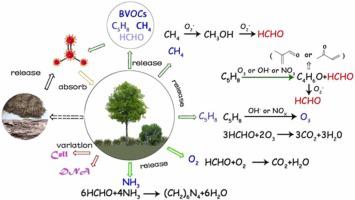Journal of Hazardous Materials ( IF 13.6 ) Pub Date : 2022-06-07 , DOI: 10.1016/j.jhazmat.2022.129304 Wan-Xi Peng 1 , Xiaochen Yue 1 , Huiling Chen 1 , Nyuk Ling Ma 2 , Zhou Quan 1 , Qing Yu 1 , Zihan Wei 1 , Ruirui Guan 1 , Su Shiung Lam 3 , Jörg Rinklebe 4 , Dangquan Zhang 1 , Baohong Zhang 5 , Nanthi Bolan 6 , M B Kirkham 7 , Christian Sonne 8

|
The wide use of hazardous formaldehyde (CH2O) in disinfections, adhesives and wood-based furniture leads to undesirable emissions to indoor environments. This is highly problematic as formaldehyde is a highly hazardous and toxic compound present in both liquid and gaseous form. The majority of gaseous and atmospheric formaldehyde derive from microbial and plant decomposition. However, plants also reversibly absorb formaldehyde released from for example indoor structural materials in such as furniture, thus offering beneficial phytoremediation properties. Here we provide the first comprehensive review of plant formaldehyde metabolism, physiology and remediation focusing on release and absorption including species-specific differences for maintaining indoor environmental air quality standards. Phytoremediation depends on rhizosphere, temperature, humidity and season and future indoor formaldehyde remediation therefore need to take these biological factors into account including the balance between emission and phytoremediation. This would pave the road for remediation of formaldehyde air pollution and improve planetary health through several of the the UN Sustainable Development Goals.
中文翻译:

植物甲醛代谢回顾:对有害排放和植物修复的影响
有害甲醛(CH 2O) 在消毒剂、粘合剂和木质家具中会导致对室内环境产生不良排放。这是非常成问题的,因为甲醛是以液态和气态形式存在的高度危险和有毒的化合物。大多数气态和大气甲醛来自微生物和植物分解。然而,植物也可逆地吸收从例如家具等室内结构材料释放的甲醛,从而提供有益的植物修复特性。在这里,我们首次全面回顾了植物甲醛代谢、生理学和修复,重点关注释放和吸收,包括维持室内环境空气质量标准的物种特异性差异。植物修复取决于根际、温度、因此,湿度和季节以及未来的室内甲醛修复需要考虑这些生物因素,包括排放和植物修复之间的平衡。这将为通过联合国可持续发展目标的若干项修复甲醛空气污染和改善地球健康铺平道路。


























 京公网安备 11010802027423号
京公网安备 11010802027423号